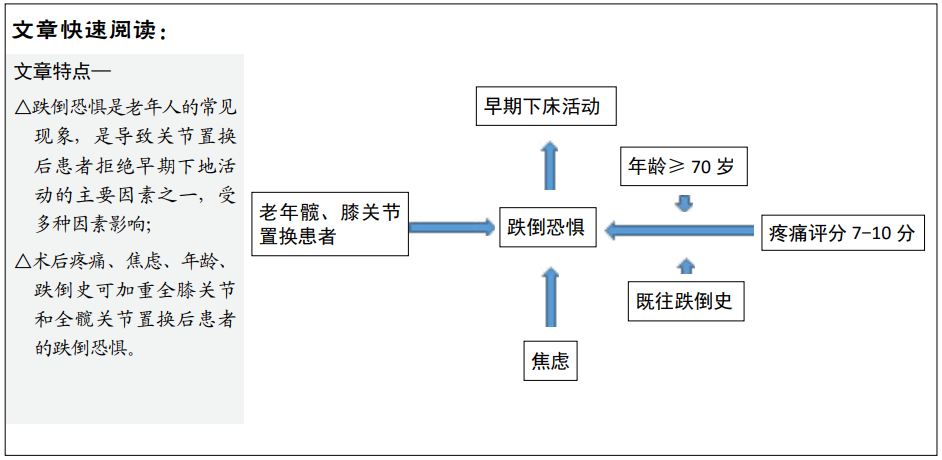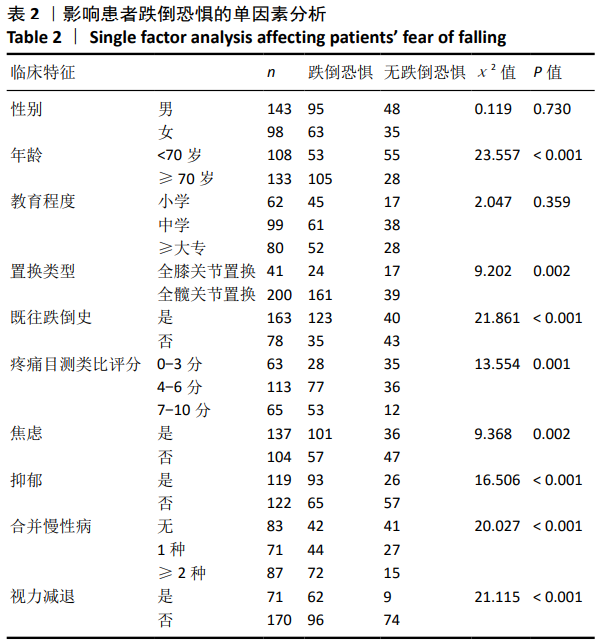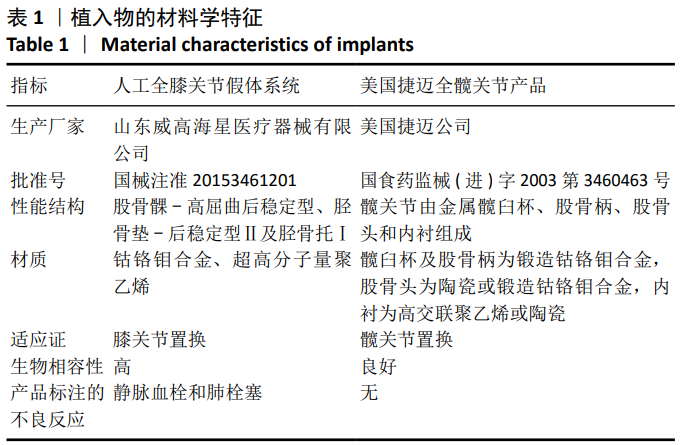[1] 严文琪,王凯,马显志,等.利伐沙班药物预防HAPC患者全髋、膝关节置换术后深静脉血栓形成的疗效观察[J].中国骨质疏松杂志,2020,26(2):294-297.
[2] 王声祥,任艳平,李楠,等.阿哌沙班、利伐沙班、达比加群酯、依诺肝素预防髋膝关节置换术后静脉血栓形成的成本-效果分析[J].中国医院药学杂志,2020,40(2):208-212.
[3] 张建,卢林,康立新. 快速康复外科理念在髋膝关节置换术中的初步应用[J]. 中国矫形外科杂志,2016,24(14):1269-1273.
[4] 张少云,黄强,徐彬,等. 髋、膝关节置换术加速康复住院时间延长的术前预测因素[J]. 中华骨与关节外科杂志,2016,9(6):530-535, 540.
[5] 谢倩倩,张咏梅,宋凌霞, 等.基于BCW理论的早期康复锻炼对老年全髋关节置换术后患者康复效果的影响[J].中国医药导报, 2020,17(7):181-184.
[6] JUDD DL, WOLFE P, LEDOUX CV, et al. Trajectories of functional performance and muscle strength recovery differ after total knee and total hip replacement: a performance-based, longitudinal study. Int J Rehabil Res. 2019;42(3):1.
[7] ZISBERG A, SYN-HERSHKO A. Factors related to the mobility of hospitalized older adults: a prospective cohort study. Geriatr Nurs (Minneap). 2016;37(2):96-100.
[8] RIDDLE DL, GOLLADAY GJ. Preoperative risk factors for postoperative falls in persons undergoing hip or knee arthroplasty: a longitudinal study of data from the osteoarthritis initiative. Arch Phys Med Rehabil. 2018;99(5):967-972.
[9] JELLESMARK A, HERLING SF, EGEROD I, et al. Fear of falling and changed functional ability following hip fracture among community-dwelling elderly people: an explanatory sequential mixed method study. Disabil Rehabil. 2012;34(25):2124-2131.
[10] 管强,韩红杰,靳令经,等.脑卒中患者跌倒恐惧的影响因素分析[J].中华老年心脑血管病杂志,2013,15(1):39-41.
[11] 王雅磊,刘腊梅,张振香.老年人跌倒评估工具的研究进展[J].中国老年学杂志,2019,39(9):2294-2298.
[12] SUNG YT, WU JS. The Visual Analogue Scale for Rating, Ranking and Paired-Comparison (VAS-RRP): A new technique for psychological measurement. Behav Res Methods. 2018;50(4):1694-1715.
[13] 王历,丁荣晶,夏昆,等. 患者健康问卷与医院抑郁量表在急性冠脉综合征患者中抑郁筛查的价值[J]. 中国心理卫生杂志,2019, 33(4):296-300.
[14] 易端,朱薇,孟秀丽,等.慢性腰腿痛患者微创术前焦虑、抑郁状态及相关影响因素分析[J].北京大学学报(医学版),2020,52(2): 285-289.
[15] WILKINSON DJ, PIASECKI M, ATHERTON PJ. The age-related loss of skeletal muscle mass and function: Measurement and physiology of muscle fibre atrophy and muscle fibre loss in humans. Ageing Res Rev. 2018;23(47):123-132.
[16] ROBERTS CE, PHILLIPS LH, COOPER CL, et al. Effect of different types of physical activity on activities of daily living in older adults: systematic review and meta-analysis. J Aging Phys Act. 2017;25(4):653-670.
[17] LAVEDÁN A, VILADROSA M, JÜRSCHIK P, et al. Fear of falling in community-dwelling older adults: A cause of falls, a consequence, or both? PLoS One. 2018;13(3):e0194967.
[18] 孙源,樊洁.社区老年人跌倒恐惧与健康自评的关系研究[J].中国全科医学,2020,23(14):1733-1739.
[19] 杨贤智,王文波.快速康复理念下髋膝关节置换围术期非手术干预措施的研究进展[J].医学综述,2017,23(13):2616-2620.
[20] DOMÍNGUEZ-NAVARRO F, IGUAL-CAMACHO C, SILVESTRE-MUÑOZ A, et al. Effects of balance and proprioceptive training on total hip and knee replacement rehabilitation: A systematic review and meta-analysis. Gait Posture. 2018;62(5):68-74.
[21] 吴朋,冉小利,黄炳强,等.多学科合作疼痛管理对全髋关节和全膝关节置换术患者快速康复的影响[J].中华麻醉学杂志, 2019, 39(8):935-938.
[22] 艾尔西丁•阿不来提,徐昌,马强,等.膝关节骨关节炎患者全膝关节置换后影响关节功能恢复的因素[J].中国骨与关节杂志, 2020,9(2):104-107.
[23] LIU JYW. Fear of falling in robust community-dwelling older people: results of a cross-sectional study. J Clin Nurs. 2015;24(3-4):393-405.
[24] MENDES DA COSTA E, PEPERSACK T, GOPIN I, et al. Fear of falling and associated activity restriction in older people. Results of a cross-sectional study conducted in a Belgian town. Arch Public Health. 2012; 70(1):1.
[25] BROWN CJ, WILLIAMS BR, WOODBY LL, et al. Barriers to mobility during hospitalization from the perspectives of older patients and their nurses and physicians. J Hosp Med. 2007; 2(5):305-313.
[26] 裴菊红,陈海霞,苟玲,等.全膝关节置换术患者疼痛灾难化的研究进展[J].中华护理杂志,2019,54(11):1752-1756.
[27] KURIEN T, ARENDT-NIELSEN L, PETERSEN KK, et al. Preoperative Neuropathic Pain-like Symptoms and Central Pain Mechanisms in Knee Osteoarthritis Predicts Poor Outcome 6 Months After Total Knee Replacement Surgery.J Pain. 2018;19(11):1329-1341.
[28] KALISCH BJ, LEE S, DABNEY BW. Outcomes of inpatient mobilization: a literature review. J Clin Nurs. 2014;23(11-12):1486-1501.
[29] OUDE VOSHAAR RC, BANERJEE S, HORAN M, et al. Fear of falling more important than pain and depression for functional recovery after surgery for hip fracture in older people. Psychol Med. 2006;36: 1635-1645.
[30] VAN HAASTREGT JCM, ZIJLSTRA GAR, VAN ROSSUM E, et al. Feelings of anxiety and symptoms of depression in community-living older persons who avoid activity for fear of falling. Am J Geriatr Psychiatry. 2008;16(3):186-193.
[31] ADLER J, MALONE D. Early mobilization in the intensive care unit: a systematic review. Cardiopulm Phys Ther J. 2012;23(1):5-13.
[32] 孙鸿雁,邓宁. 首发脑卒中患者跌倒恐惧状况与生活质量的相关性研究[J]. 护理学杂志,2017,32(15):76-78.
[33] 徐艳华,唐起岚,聂贝贝, 等.急性缺血性脑卒中偏瘫患者行走步态特征与跌倒恐惧的相关性研究[J].中华现代护理杂志, 2019, 25(25):3232-3235.
|




